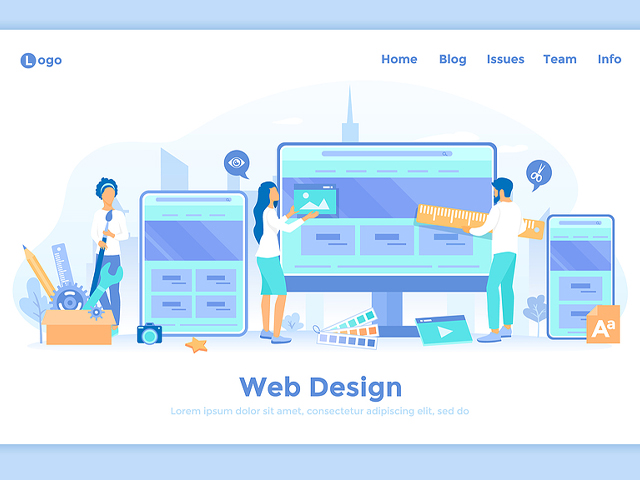Web design theory is the first thing you will need to learn for becoming a Web Designer. There are basic principles for making great websites. Learn the fundamentals of color theory, structure and user experience.
There are numerous avenues you can explore to learn the theory of web design. Try enlisting in a bootcamp or a web design course. There are web development bootcamp options and UX design courses. The bootcamps are intense and short education programs to immerse yourself in. They can take complete newbies to design and tech and transform them into job-ready Web Designers in as little as 4 months of full-time classes.
Since the web design field is continually evolving, learning the theory of web design is different from studying other kinds of theoretical learning. Good Web Designers are continually upgrading their skills and constantly learning.
Understand the Key Tools of Web Design
There are many web design tools you will need to learn before you become a Web Designer. These tools have evolved over time and web design software has grown significantly. Web Designers have a plethora of exciting tools at their disposal to create gorgeous, functional and intuitive websites.
WordPress
WordPress has been a leader in web design for ages. It has more than a thousand built-in plugins and themes to streamline and optimize websites, allowing you to enhance, build, customize and edit with ease. It powers twenty-seven percent of the websites on the Internet. WordPress owns a whopping seventy-six percent market share across the globe in CMS.
Photoshop
Photoshop is your go-to source to create eye-catching images. As a Web Designer, you will be using visuals constantly. It offers endless color choices and various gradients to provide you with all the features to create exciting prints and creative designs.
Dreamweaver
Dreamweaver is another Adobe suite component that is beneficial to become familiar with. Even if you are not a programming professional, Dreamweaver allows you to directly code your website design. There is an array of tools and design templates that are ready-made which newcomers may find useful for creating a responsive and attractive design.
Sketch
Sketch is mostly utilized for interface designs. It is an excellent tool for prototyping and making interfaces. Sketch can dramatically simplify things when you are working with graphics and vector drawings.
Google Web Designer
Google Web Designer allows you to make visually compelling HTML5 content. It allows you to bring your creative ideas to life. This program delivers interactive elements and animation while seamlessly integrating them with other Google features such as Google Drive and Google Ads.
Grow Your Web Design Skills By Working On Your Own Projects
Once your web design tools are understood, you can start creating websites. As you experiment, you will discover many skills you may not have seen coming. Certain "hard" skills or technical skills like programming in JavaScript, CSS, or HTML will occur. Jumping in and getting started is the best way to practice your abilities. The more websites you build, the more you will learn and the better you will become.
When you are building websites, pretend you are a user and interact with them accordingly. This will help you discover any navigational problems or issues. This will help you determine what improvements need to be made. Getting into the mind-frame of a UX Designer will help you create solid websites.
Showcase Your Web Design Work With Your Portfolio
The best tool you can use when applying for jobs is your creative portfolio. Ensure that you offer a diverse and concise portfolio. Showcase items you are proud to show off. Don't bother filling it up with websites that don't make you proud. It is vital to show that you have designed a variety of sites that have unique esthetics. Customize your portfolio to where you are applying to broadcast work that aligns with the feel and look of the company.
What makes you stand out as a Web Designer? It is important to know this to have a stellar portfolio. Pick work that highlights your strengths. Ensure both the UX and UI are perfect.
Employers want to see how you created these stunning websites. It is common for Web Designers to use text to dictate their thought process and outline how they solved issues throughout the project. This shows that you are a good communicator as well, which is an important soft skill for Web Designers to possess.
Apply to Web Design Jobs
There are tons of different web design roles in the field. A person who has the right combination of experience and education and web design skills can qualify for any of the following:
- Visual Designer
- Web Designer
- Interaction Designer
- UX/UI Designer
- Front-End Designer
- Product Manager
If you have just finished an educational program or bootcamp, an entry-level job is a great place to start. If you have previous tech experience, even if it is not in the web design category, you may qualify for higher-paying jobs. Look beyond Silicon Valley as cities such as New York, Chicago and Boston are desperate for quality workers. There is opportunity all over with such technical talent scarcity.
Some people choose to use a recruiter and hand their portfolio and resume over to find a suitable employer. If you attended a bootcamp, many offer career help including portfolio/resume assistance and interview prep. Check into these resources and take advantage of them if you are hunting for a job.
What are the Various Kinds of Web Designers?
There are 3 different kinds of Web Designers out there. They have three different work environments. See which one speaks to you: in-house Web Designers, Agency Web Designers and Freelance Web Designers.
Freelance Web Designers
Do you dream of being self-employed? You will have to market and manage your business and finish the design work you have been commissioned to make. This choice means deciding if picking your own projects is worth the effort and time required to find clients and run your business. There are a variety of perks that come with being a freelance Web Designer. Enjoy a flexible schedule, creative control and unlimited salary potential. However, you will need to be dedicated to hard work and have the discipline to make this happen. Having the right training can help you achieve a successful career in Web Design.
Agency Web Designers
When you are an Agency Web Designer, you will have a salary and some security. However, be prepared to surrender most or all of your control over which clients and projects you need to take on. Some agencies may specialize in particular niches or industries. This can affect how much you enjoy working there. Try to apply to places that have similar interests if they are competing in a specialized market.
In-House Web Designers
In-House Web Designers often work on one main website for a company. They may only be responsible for a certain section of the website or a particular feature on the website. For instance, a person may exclusively work on the website's mobile features.
Education and Responsibilities
It is common for Web Designers to have some kind of formal education ranging from a diploma in fine arts, a university, or college education, or a background in graphic design. Some people choose to take a certification class or attend bootcamp.
The training generally covers website design, cover design theory, user research and responsive design. It also includes the technicality of a Web Designer's job such as specific tools, certain programs and other attributes a Web Designer requires.
Web Designers may choose to work initially at an agency or at an in-house business to build up their network contacts and jazz up their portfolios before venturing into self-employment. If you have some time to establish your clientele and grow your design software skills, it may be possible to save some money during this process which can help fund your business launch in the future.
There will be opportunities to take on side projects from these main jobs. You may gradually go into freelance Web Designing and get a feel for the ups and downs until you build a big enough client base to make it your full-time gig
It's never too early to start planning your business. Freelancers need to have their own company websites that are professional, esthetic and free from any copy or code errors. Imagine the website exists to help clients contact you and doubles as your marketing. Many choose to post their portfolio and resume on their website too.
If you are just beginning in this field, you may choose to offer your Web Design services to charities or volunteer groups. During this time, it is important to note that your initial freelance jobs will probably not offer a huge payday. Build up your experience and your reputation for quality and you will be charging more and earning more in no time.
Is there a High Demand for Web Designers?
The demand for skilled Web Designers continues to rise at an exponential pace. Since all business’s web offerings are essential to their bottom line, ensuring the useability and design is top-notch is vital to their success.
Web Designers who can code are in even more demand, particularly if they have some back-end knowledge. A Web Designer who also knows programming languages such as Python, SQL, HTML, JavaScript and CSS stands out above the crowd. Of course, they also command a higher salary. This is the reason many Web Designers choose to take web development classes to round out their skills.
User Experience or UX skills are exceptionally valuable for a Web Designer to know. Mastering design strategy and research, UI design, UX design fundamentals, responsive design and how to deliver visualizations will make you highly sought after as a Web Designer. You will be a huge asset to any company.
How much do Web Designers make?
According to PayScale, the average salary for a Web Designer is 50K and there may be perks and bonuses up to 5K. This wage increases with experience. A Senior Web Designer earns about 71K and up to 10K in bonuses.











